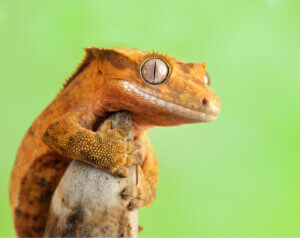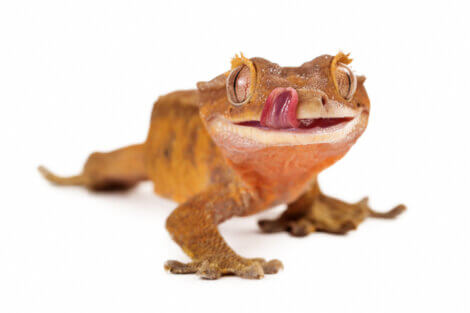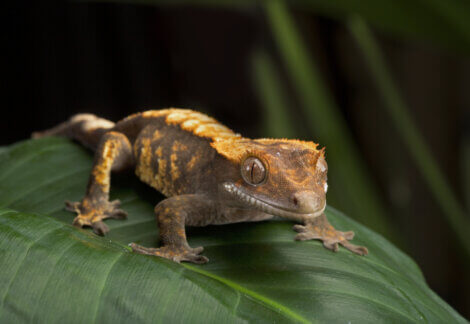Keeping a Crested Gecko as a Pet


Written and verified by the biologist Samuel Sanchez
Can you imagine having a miniature dragon in your house? Well, maybe you don’t want a pet quite as large and dangerous as that, but if you’re interested in keeping an exotic animal, the Crested Gecko (Correlophus ciliatus) could be just what you’re looking for!
Despite their small size and pretty appearance, they’re actually one of the most resilient reptiles on the planet. However, just like any exotic animal, they need a very controlled environment if they’re going to survive. Today, we’ll tell you more about the crested gecko.
Characteristics and considerations
Before we get started, we’ll just give you a quick warning: this species is currently being considered for inclusion in the CITES agreement. This means that it’s possible that they might be much more tightly regulated in the future.
According to the International Union for the Conservation of Nature (IUCN), this is because the crested gecko is currently a vulnerable species and their natural populations are declining. As a result, it’s important for anyone thinking of adopting one to make sure they go to a certified breeder.
Otherwise, you’ll be directly contributing to their disappearance from their natural habitat.

General features
The crested gecko is native to New Caledonia, a French territory that includes dozens of islands in the south Pacific. Due to the latitude in this part of the world, the climate is predominantly tropical. This is an important thing to remember if you’re thinking of getting a crested gecko.
The following are typical features of this species:
- Despite being a medium-sized reptile, they’re one of the larger species of gecko. They can reach 8-9 inches in length from head to tail.
- They have a triangular head with two very distinctive crests on the sides.
- This reptile is perfectly adapted for a nocturnal lifestyle and has highly developed sight and hearing.
- They’re generally a brownish-green color, which helps them to blend in against vegetation.
Overall, this reptile is a nocturnal tree-dwelling animal that needs a very specific climate to survive. Below, we’ll give you some tips on keeping one happy and healthy at home.
Caring for a crested gecko in captivity
Firstly, it’s important to say that their terrarium should be much taller than it is long. Crested geckos have very strong limbs with sticky fingers (lamellae), and, as a result, they love to climb and jump from branch to branch.
Therefore, an ideal terrarium for a pair of geckos would be about one and a half feet square and two feet tall. If you’re thinking of getting three, it would be best to get one up to three feet tall. But be careful: the males are extremely territorial.
If you get three, they should always be made up of two females and a male.
Their diet mainly consists of fruits and insects, and, luckily, specialist pet shops send specially prepared feed at a reasonable price. But even so, their meals should also be accompanied by some live feed, such as crickets, cockroaches, or worms. After all, they are predators!
As for their environment, the crested gecko needs 60 to 80% humidity and a temperature between 64 and 82 °F. You should be able to easily control the temperature with a heat mat and a thermostat, but the humidity is a more complex matter.
A difficult parameter to control
The following tips can be useful for making sure that your gecko’s habitat is kept at the right humidity:
- A glass terrarium: whilst it will need ventilation and some metal grills in strategic positions, glass terrariums tend to maintain humidity levels a little better.
- Daily watering: use a spray bottle first thing in the morning and last thing at night. Not only will it help maintain the humidity levels but also briefly simulate the gecko’s natural environment.
- Place plenty of plants and vegetation in the terrarium.
- Use an automatic sprinkler system: this is more expensive but definitely more effective. This system will spray water in the terrarium automatically.
- Place a hygrometer in the terrarium: get one that sticks to the glass so that you can measure the humidity levels. These are very useful and inexpensive.
- Use a substrate on the base of the terrarium that retains humidity, like coconut fibers.

A long-term investment
As you can see, adopting a crested gecko involves a significant initial investment. The terrarium, the plants, the substrate, a heat mat, a rain system, and the animal themselves can easily cost around $250.
However, once everything is set up, these reptiles are very low maintenance and their food is very cheap. If you plan properly in advance and don’t skip on the essentials, you can enjoy this animal’s company for up to 20 years.
Can you imagine having a miniature dragon in your house? Well, maybe you don’t want a pet quite as large and dangerous as that, but if you’re interested in keeping an exotic animal, the Crested Gecko (Correlophus ciliatus) could be just what you’re looking for!
Despite their small size and pretty appearance, they’re actually one of the most resilient reptiles on the planet. However, just like any exotic animal, they need a very controlled environment if they’re going to survive. Today, we’ll tell you more about the crested gecko.
Characteristics and considerations
Before we get started, we’ll just give you a quick warning: this species is currently being considered for inclusion in the CITES agreement. This means that it’s possible that they might be much more tightly regulated in the future.
According to the International Union for the Conservation of Nature (IUCN), this is because the crested gecko is currently a vulnerable species and their natural populations are declining. As a result, it’s important for anyone thinking of adopting one to make sure they go to a certified breeder.
Otherwise, you’ll be directly contributing to their disappearance from their natural habitat.

General features
The crested gecko is native to New Caledonia, a French territory that includes dozens of islands in the south Pacific. Due to the latitude in this part of the world, the climate is predominantly tropical. This is an important thing to remember if you’re thinking of getting a crested gecko.
The following are typical features of this species:
- Despite being a medium-sized reptile, they’re one of the larger species of gecko. They can reach 8-9 inches in length from head to tail.
- They have a triangular head with two very distinctive crests on the sides.
- This reptile is perfectly adapted for a nocturnal lifestyle and has highly developed sight and hearing.
- They’re generally a brownish-green color, which helps them to blend in against vegetation.
Overall, this reptile is a nocturnal tree-dwelling animal that needs a very specific climate to survive. Below, we’ll give you some tips on keeping one happy and healthy at home.
Caring for a crested gecko in captivity
Firstly, it’s important to say that their terrarium should be much taller than it is long. Crested geckos have very strong limbs with sticky fingers (lamellae), and, as a result, they love to climb and jump from branch to branch.
Therefore, an ideal terrarium for a pair of geckos would be about one and a half feet square and two feet tall. If you’re thinking of getting three, it would be best to get one up to three feet tall. But be careful: the males are extremely territorial.
If you get three, they should always be made up of two females and a male.
Their diet mainly consists of fruits and insects, and, luckily, specialist pet shops send specially prepared feed at a reasonable price. But even so, their meals should also be accompanied by some live feed, such as crickets, cockroaches, or worms. After all, they are predators!
As for their environment, the crested gecko needs 60 to 80% humidity and a temperature between 64 and 82 °F. You should be able to easily control the temperature with a heat mat and a thermostat, but the humidity is a more complex matter.
A difficult parameter to control
The following tips can be useful for making sure that your gecko’s habitat is kept at the right humidity:
- A glass terrarium: whilst it will need ventilation and some metal grills in strategic positions, glass terrariums tend to maintain humidity levels a little better.
- Daily watering: use a spray bottle first thing in the morning and last thing at night. Not only will it help maintain the humidity levels but also briefly simulate the gecko’s natural environment.
- Place plenty of plants and vegetation in the terrarium.
- Use an automatic sprinkler system: this is more expensive but definitely more effective. This system will spray water in the terrarium automatically.
- Place a hygrometer in the terrarium: get one that sticks to the glass so that you can measure the humidity levels. These are very useful and inexpensive.
- Use a substrate on the base of the terrarium that retains humidity, like coconut fibers.

A long-term investment
As you can see, adopting a crested gecko involves a significant initial investment. The terrarium, the plants, the substrate, a heat mat, a rain system, and the animal themselves can easily cost around $250.
However, once everything is set up, these reptiles are very low maintenance and their food is very cheap. If you plan properly in advance and don’t skip on the essentials, you can enjoy this animal’s company for up to 20 years.
All cited sources were thoroughly reviewed by our team to ensure their quality, reliability, currency, and validity. The bibliography of this article was considered reliable and of academic or scientific accuracy.
- Correlophus ciliatus, IUCNRedlist.org. Recogido a 21 de octubre en https://www.iucnredlist.org/species/176173/123715909
- Mantenimiento del gecko crestado. geckoscrestados.com. Recogido a 21 de octubre en https://www.geckoscrestados.es/mantenimiento-geckos/
This text is provided for informational purposes only and does not replace consultation with a professional. If in doubt, consult your specialist.








